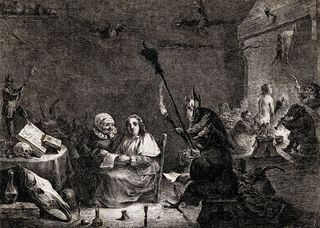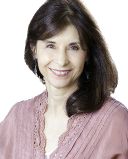Relationships
Mothers, Witches, and the Power of Archetypes
Finding the archetypes behind destructive influences can help us cope with them.
Posted May 31, 2016 Reviewed by Ekua Hagan

Anyone who has been raised by a cruel or neglectful mother can attest to a painful legacy of rejection. The effects of deprivation of good maternal care are uncontestably at the core of a host of psychological maladies.
Our first relationship is with our mothers. Across cultures, an infant’s first attempt at word-forming starts with babbling the sound Ma—mommy, maman, mater, mutti, amma, mare—as if from birth we are programmed to call out to the person most likely to sustain our lives.
But what do we make of negative mothers — those who do not care for and attend to us? Once, on a friend’s sheep farm where I’d gone to help with lambing, I witnessed the sad spectacle of a mother ewe rejecting her offspring. Tottering on its weak legs, the lamb struggled to nuzzle and suckle, but the ewe shoved the lamb from its udder. The lamb tried again, and again the ewe kicked and butted until the newborn lamb collapsed and gave up. Recently, while reading Peg Streep’s excellent book, Mean Mothers, this haunting image returned to me. Streep wrote:
“... not all mothers love, unconditionally or otherwise. For the mother who doesn't, the cultural myths of unconditional love and maternal instinct require her to hide and deny her feelings at all costs, even if she cannot always keep herself from expressing them in words or gestures. There's no room in the mother myth for the mother who resents all the attention her infant or toddler needs, or who chafes at the necessary loss of freedom and self-focus the transition into motherhood usually entails.”
Our personal mother may be cruel and inadequate in fulfilling our needs, but it’s helpful to enlarge our understanding of their influence by exploring the archetypal dimensions of motherhood and situating the personal within the context of the universal. As Carl Jung wrote in Four Archetypes:
“ ... all those influences which the literature describes as being exerted on the children do not come from the mother herself, but rather from the archetype projected upon her, which gives her a mythological background and invests her with authority and numinosity.”

Behind the personal mother is the archetype of the Great Mother. She is the force that drives creation and destruction, fecundity but also the barren womb.
The Great Mother is Mother Nature who brings us fruit and grain but also hurricanes, drought, and locusts. She is Gaia, Demeter, Isis, and all the other goddesses from the beginning of time who have been worshipped and propitiated, demonized and thrown out. She is not our birth mother; she is our psychic heritage of what motherhood attains, and she carries within her the poles of good and bad mothers that come down to us through fairy tales and myths.
“These are three essential aspects of the mother," wrote Jung. "Her cherishing and nourishing goodness, her orgiastic emotionality, and her Stygian depths.”
We know the bad mother as the queen in Snow White, as Cinderella’s stepmother, as Circe or Medusa, whose gaze turns us to stone. These figures stand for a reversal of positive mothering. Instead of providing food and comfort, they seduce and devour, harboring a secret malicious intent. They “eat up” our self-confidence or numb us with their betrayal.
Many of us read these tales and identify ourselves in the narrative. We say, Yes, my mother is just like that, and we can understand that from the beginning of time there have probably been mean mothers, and realize, because of this long history, that we, too, can survive our own.
Among the archetypes, the witch is a fascinating figure. When someone calls another “a witch,” we know exactly what they mean. The witch has powers. She is uncanny and unholy. She lives outside the borders of civilization and has been ostracized because her ways stand in opposition to accepted values, thus challenging our own impulse to conform. To not conform, especially as women, puts us at risk of being called a witch (or the rhyming word that begins with a B).
Ann and Barry Ulanov wrote in The Witch and the Clown: Two Archetypes of Human Sexuality:
“The witch figure presents an awesome image of the primordial feminine concern with herself. Maternal life spends itself like life’s blood flowing outward to nourish the sounds and bodies of loved ones. In the witch figure, life flows inward and downward to fuel the dark recesses of a woman’s psyche or a man’s anima.”
The witch reminds us there may well be unnamable and untamable aspects of ourselves where passions stagnate and fester. What parts of us don’t fit into the conventional idealized feminine? Do we harbor an urge that wishes to transgress and to cross borders? Historically, innocent women have been tortured and killed because the prevailing masculine rule feared female sexuality.
What if we draw on the full complexity of the mother archetype and think of our mean mothers in another way: as women whose creativity has been stifled, the vital flow of their creative energies dammed up, ignored or rejected, and thus unavailable to be consciously used? Without a positive outlet, these women may experience a fixed negativity that damages their ability to nurture.
The hundreds of similar fairy tales illustrate the universality of certain psychic phenomena. In most tales, the witch is a persecutory figure. She pounces on victims who feel helpless to defend themselves.
In reality, young children can be helpless victims of parental neglect, and good fairies do not always intercede. But as adults, we can see beyond our own situations to the archetypal dimensions that underlie our present reality and discover we do not suffer alone.
In these tales, help of some sort usually steps forward to rescue the heroine, often in the form of animals, birds, or toads. We can hope that these also represent archetypes: inner helpers cultivated in our own psyches who will lead us out of harm’s way.
Keep up with Dale by liking her Facebook page, and read more from Dale on her blog.




